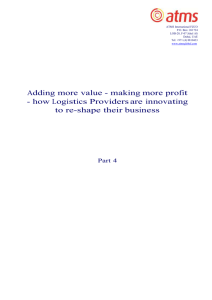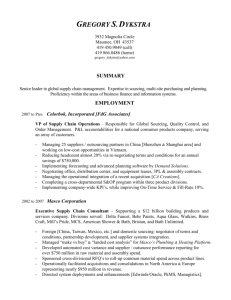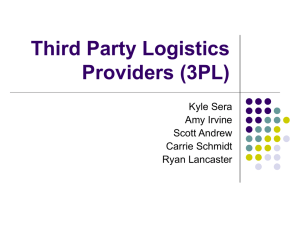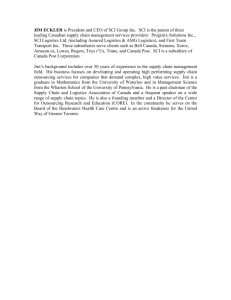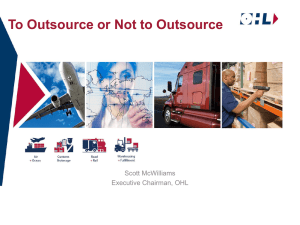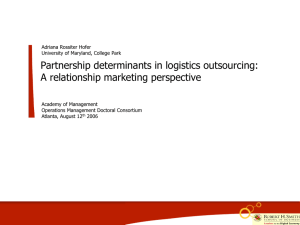Logistics Outsourcing - A Panacea
advertisement
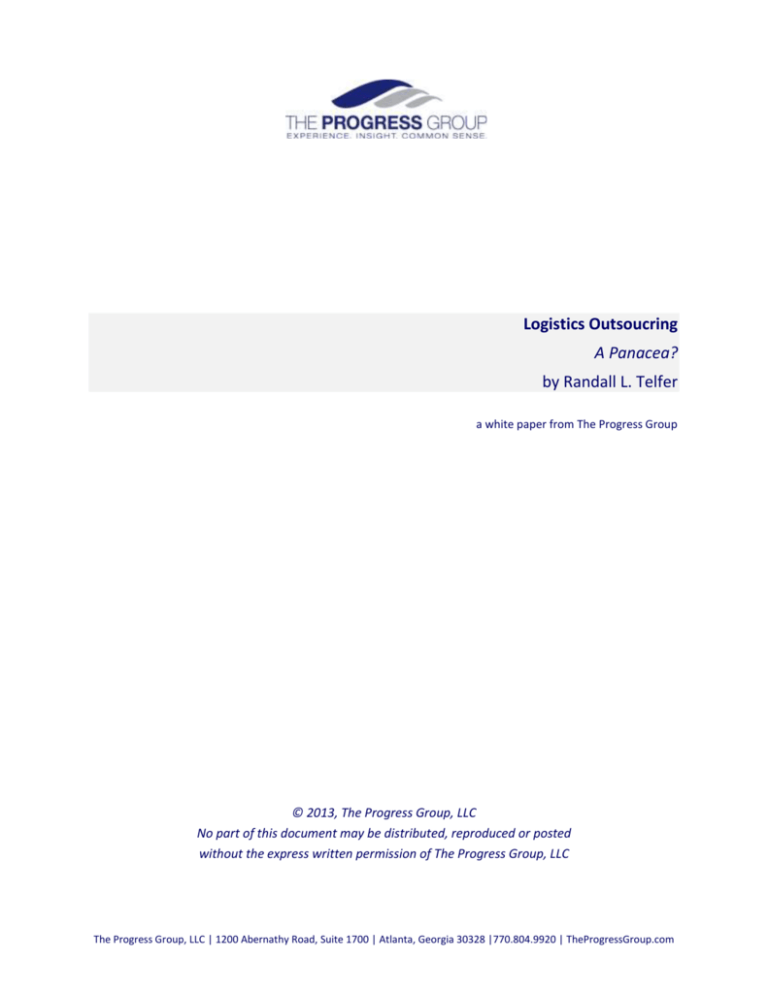
Logistics Outsoucring A Panacea? by Randall L. Telfer a white paper from The Progress Group © 2013, The Progress Group, LLC No part of this document may be distributed, reproduced or posted without the express written permission of The Progress Group, LLC The Progress Group, LLC | 1200 Abernathy Road, Suite 1700 | Atlanta, Georgia 30328 |770.804.9920 | TheProgressGroup.com Logistics Outsourcing - A Panacea? By Randall L. Telfer, The Progress Group Now that we have entered the 21st century, outsourcing logistics activities has become a hot topic . . . often red hot! The practice is not only a popular topic; it is no longer confined to transportation and warehousing activities. Sourcing and procurement are now fair game. Some companies even have what they call "virtual manufacturing," a polite term for someone else doing the heavy lifting. We read and hear of many successes. Strangely, the failures are less well-publicized . . . and they can be spectacular. We have been practitioners and promoters of outsourcing for over a dozen years, and our clients are living proof that outsourcing can elevate service offerings, reduce costs, and re-deploy and re-leverage precious corporate assets in a wide variety of industries. But, we have learned by experience, sometimes referred to as "the hard way." And, we think that lessons learned in the past have been valuable in the present, in avoiding pitfalls and building up the likelihood of success. It's not getting any easier, though. The process complexity involved in outsourcing, whether of the third-party logistics or any other variety, has not simplified over time. Instead, it has increased. In the rush to assess the relevance, scope, and proper timing of outsourcing, an objective methodology is paramount to successfully discovering the path that takes you where you need to go. Following a rational, defensible process is the single most important ingredient in reaching your outsourcing objectives. Also, consider that business leadership (your boss or your boss's boss) will periodically cut into your timeline and attempt to bring in perceived deliverables, benefits, and savings sooner than they can actually be achieved. An options orientation throughout the process is very healthy. The methodology that we have used successfully, following strategic decisions on the scope and role of outsourcing in overall supply chain operations, covers seven key areas. They include: Base lining Risk assessment Benchmarking Request for proposals Contracting for value Selection Implementation To be blunt, methodologies aren't very exciting on the surface. It is the detail behind the bullet points that give them weight and value. In the end, they are really only as good as the experience, insight, and creativity of the people who are leading their execution. That said, let's dig a little deeper into what makes up the backbone of a sound outsourcing methodology. BASELINING A detailed baseline to include financial and service quality elements is one of the most important tasks in the entire process. It should be carefully aligned with the company's goals and their priorities; no relief on making the tough choices, here. The base lining should be as organized and reliably quantified as possible - the 3PL companies will hang their Return on Sales (ROS) on the quality of the analysis. It will have to survive the test of a full audit with your financial Page 2 leadership and 3PL audit teams. Logistics and related physical distribution costs will need to be delineated at the site/provider/cost center level. RISK ASSESSMENT This category is cross-functional in nature and should reflect the process that is used throughout Company operations, not just the logistics and commercial organizations. If outsourcing grows to be a real possibility, the sequencing of actions/plans/communications will be critical to success. Misplaced workforce sensitivities and attrition of key employees can undermine (or worse) the best planning at almost any stage, and at more than one point. In the Benchmarking category, below, you will find an assessment of the 3PL's culture and its compatibility with the company's looms as important as the financial and service quality base lining. Also, for the next year or so, Y2K impediments can complicate implementation timing and exacerbate resource constraints. BENCHMARKING Benchmarking, correctly done, involves significant pre-work. It's not just a visit or flyby. It should be a full physical of an operation's anatomy and a deep probe of its mental health as well. We would suggest benchmarking similar, non-competing operations that are being led by a 3PL. The full diagnostic should evaluate proven proficiency in, to illustrate: Logistics planning acumen - all transport modes, domestic & international Logistics technology/investment Career paths and development of 3pl leaders, e.g., operations and it, site leaders and warehouse associates Carrier & warehouse portfolio integration Business team integration Quarter/year end proficiency Cost effectiveness Service quality focus Established metrics with historical performance measurements The benchmarking team should be comprised of the best and brightest from Quality, Finance, IT, Sourcing and Operations. REQUEST FOR PROPOSAL A standardized format, which itemizes costs that can be easily compared with the base lining data, is certainly in order. A bold statement, which prohibits asterisks or caveats, will equalize the competitive playing field. As not all 3PL's are equal in their quality of project management, technology and leadership, you should structure the RFP to assess/rate these salient attributes• which you should in turn edit, based on your benchmarking. Of special note, international logistical planning and supporting software still doesn't appear to be a proven 3PL core competency. And, if your logistics network hasn't been "refreshed" in size, scale, and functionality in the last 3-4 years, you should upgrade its composition and direction with a front-end network analysis. Page 3 CONTRACTING FOR VALUE Contracting for value is intended to improve financial and service quality performance; not lop off costs and risk customer relationships. Gain sharing and activity-based contracting can lead to effective 3PL partnerships Gain sharing is a mechanism that can reward, on a prorated basis, both the company & the 3PL for delivering savings. It can be particularly effective in reaching, and even exceeding, "stretch" targets. The gain sharing savings can become a major contributor to a manager's ability to meet Company-imposed productivity and savings performance targets. Activity-based contracts can tilt benefits toward the Company, particularly in cases when customer demand is volatile or seasonal. However, while the company might enjoy minimal costs during periods of low volume, the 3PL can easily become disenchanted by an irregular, especially an unpredictable, revenue stream. Interesting project scope and value-added services discussions generally follow these conditions. Depending on what components of the supply chain you are looking to outsource, risks and rewards on inventory management might not be easy for a manufacturer to relinquish. Further, it is almost certainly difficult for the 3PL to take on the risk, if the 3PL's scope doesn't include forecasting and demand planning. Also, you will probably face superficially less attractive savings if your budget doesn't reflect imputed interest charges incurred at the corporate level. Be wary as discussions evolve during the contracting process, and the length of the agreement's term creeps upward to five, or even ten years. It is generally very complicated and very costly to get out of a multi-year deal with a 3PL that is well integrated into your business processes. (Always have a contingency plan. Always.) SELECTION The selection step assumes not only that the preceding steps have been executed, but also that you and your management feel good about all of the previous assessment and development work. At this point in the process, some well known companies have split their outsourcing award, or assigned sites between two lead 3PL companies. We are convinced that this leads to supply chain fragmentation and inordinate confusion. The selected service providers must be intimate and integrated with you to gain the greatest benefit, and to achieve the promise of outsourcing. They can't be treated the way companies used to treat competing materials suppliers, which leads to a wrong kind of competition and a misdirection of energy and effort. The only valid premise for selecting multiple service providers is one in which each would have clearly defined roles and responsibilities, based on their capabilities and geographic presence, in a three-way relationship with the Company. Implicit in the selection step is the development of an explicit Company-CEO and 3PL-CEO bond, in which they codevelop common vision and objectives for the outsourcing initiatives. IMPLEMENTATION Far too many CEO's (and sometimes logistics professionals) underestimate the complexity of even niche outsourcing, let alone a total outsourcing solution. Here are some "Golden Rules" to keep in mind as you plan and proceed with implementation: Implement on a full fiscal year calendar cycle (unless business needs are compelling); e.g., begin 1/1 as opposed to 8/1 to make the quarterly and year-to-year financial comparisons significantly cleaner Page 4 Don't downsize the existing logistics team prematurely; individuals may fit with the 3pl company's plans or needs Assign singular project leadership to the 3pl, with joint direction from a company/3pl directorate - joint project management doesn't work Plan early and often and do as much as possible beforehand, and over-commit resources - site conversions are almost always rushed; especially in it and training Build in operational and business case contingencies for unforeseen delays that could dilute or delay savings realization Take the longer view on where to house 3pl project leadership, placing them where the real action is they can lead on the floor, but they can only follow from headquarters Revisit risk assessment, probabilities, dependencies, and mitigation actions/strategies for the details of the implementation plan(s) ________________________________________ Logistics outsourcing is a major cultural integration, whether you manufacture and distribute or simply distribute as you go to market. If your company's business strategy, capitalization or reinvestment ratio do not lead to annually investing in logistics processes and technology and in a major way, outsourcing can make more than good sense. It may be the only practical way for you to satisfy the service needs of your customers as the pace of competition steps up. Remember to keep the options orientation, do a world-class job of base lining, choose a 3PL as if you were selecting a spouse, and build multi-level organizational bonds within the 3PL partnership relationship. In conclusion, is outsourcing a panacea? Of course not. But, depending on your Company's circumstances, it can be a cure. Outsourcing can definitely maintain your competitiveness, help meet your cost objectives, drive up asset utilization, and get right with your Company's strategic focus. About The Progress Group The Progress Group is an independent management consulting firm delivering strategy to implementation services in logistics/supply chain, operations design, performance management and program management. Our clients benefit from our depth in experience, thought leadership, analyticsbased thinking and always objective client advocate viewpoint. Founded in 1991 by industry leaders, we partner with our clients to enhance competitive position and improve performance. The Progress Group is headquartered in Atlanta, GA. For more information, visit www.TheProgressGroup.com. Page 5
